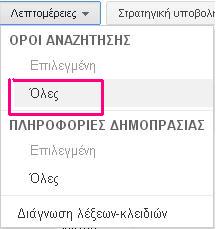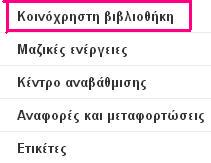Αρνητικές λέξεις-κλειδιά
Ένας τύπος λέξης-κλειδιού που αποτρέπει την ενεργοποίηση της διαφήμισής σας από μια συγκεκριμένη λέξη ή φράση. Υποδεικνύει στο Google να μην προβάλλει τη διαφήμισή σας, όταν κάποιος αναζητά αυτήν τη φράση.
- Για παράδειγμα, αν προσθέσετε τη λέξη “δωρεάν” ως αρνητική λέξη-κλειδί στην καμπάνια ή την ομάδα διαφημίσεών σας, στέλνετε εντολή στο AdWords να μην προβάλλει τη διαφήμισή σας για οποιαδήποτε αναζήτηση περιέχει τον όρο “δωρεάν”. Στο Δίκτυο εμφάνισης, η διαφήμισή σας είναι λιγότερο πιθανό να εμφανιστεί σε έναν ιστότοπο όταν οι αρνητικές λέξεις-κλειδιά αντιστοιχούν στο περιεχόμενο του ιστότοπου.
- Ένας παρόμοιος όρος είναι αρνητική αντιστοίχιση, μία από τις τέσσερις επιλογές αντιστοίχισης λέξεων-κλειδιών που χρησιμοποιείται για να περιγράψει αρνητικές λέξεις-κλειδιά.
- Προσθέστε αρνητικές λέξεις-κλειδιά στην καρτέλα λέξεις-κλειδιά κάνοντας κλικ στο στοιχείο “Αρνητικές λέξεις-κλειδιά” κάτω από τον κύριο πίνακα.
- Οι αρνητικές λέξεις-κλειδιά αποτελούν σημαντικό κομμάτι κάθε καμπάνιας, επειδή διασφαλίζουν ότι οι διαφημίσεις σας εμφανίζονται μόνο στους χρήστες που ψάχνουν αυτό που προσφέρετε. Αυτό το πρόσθετο επίπεδο ελέγχου μπορεί να σας βοηθήσει να αυξήσετε την αναλογία κλικ, εμφανίσεων (CTR), να βελτιώσετε το μέσο κόστος ανά κλικ (CPC) και να βελτιώσετε την απόδοση επένδυσης (ROI).
Η προσεκτική επιλογή των κατάλληλων λέξεων-κλειδιών, αποτελεί ένα σημαντικό βήμα για να σχεδιάσετε μια αποτελεσματική καμπάνια στο Google AdWords. Σκεφτείτε όπως οι πελάτες σας, χρησιμοποιείστε το Εργαλείο Λέξεων-Κλειδιών (Keyword Tool) και θα χτίσετε την αντιπροσωπευτική λίστα με τις λέξεις που θα ενεργοποιούν τις διαφημίσεις σας. Όμως, η προσθήκη αρνητικών λέξεων-κλειδιών αποτελεί τον ακρογωνιαίο λίθο για την επιτυχία της καμπάνιας σας. Οι συμβουλές των AdWords Experts του Papaki.gr θα σας βοηθήσουν να σχεδιάσετε μια αποτελεσματική στρατηγική για τις αρνητικές λέξεις-κλειδιά και να αυξήσετε την απόδοση της επένδυσής σας ακολουθώντας 6 απλά βήματα!
Γιατί να καταχωρήσω αρνητικές λέξεις-κλειδιά;
Οι αρνητικές λέξεις-κλειδιά, εάν επιλεγούν και εφαρμοστούν σωστά, μπορούν να σας γλιτώσουν χρόνο και χρήμα, γιατί:
– αποτρέπουν την εμφάνιση των διαφημίσεών σας στους χρήστες που δεν αποτελούν το κοινό σας,
– εξαιρούν τους χρήστες που αναζητούν κάτι διαφορετικό από αυτό που εσείς παρέχετε,
– φιλτράρουν τις ανεπιθύμητες εμφανίσεις και κλικ,
– σας γλιτώνουν από ανεπιθύμητες χρεώσεις και άρα, μειώνεται το κόστος,
– σας βοηθούν να επιτύχετε υψηλό CTR και άρα, να αυξήσετε τις πιθανότητες για ένα εξίσου υψηλό Quality Score,
– σας καθοδηγούν να επενδύσετε τον διαφημιστικό προϋπολογισμό σας έξυπνα και στοχευμένα και άρα, να βελτιώσετε την απόδοση της επένδυσής σας (ROI).
Για να μάθετε πώς θα επιλέξετε τις αρνητικές λέξεις-κλειδιά και πώς θα ωφελήσουν στην απόδοση και επιτυχία της καμπάνιας σας, ακολουθήστε 6 συμβουλές που συγκεντρώσαμε για εσάς:
1. Χρησιμοποιήστε τα Reports του AdWords
Η αναφορά Όρων Αναζήτησης (Search Query Report ή SQR) είναι ακριβώς ότι χρειάζεστε, διότι σας εμφανίζει τους ακριβείς όρους που χρησιμοποίησαν οι χρήστες στην αναζήτησή τους και εμφανίστηκε η δική σας διαφήμιση. Η καμπάνια σας θα πρέπει να τρέχει ήδη για μερικές μέρες για να δείτε τις αναζητήσεις που κάνουν οι χρήστες. Έτσι, μπορείτε να δείτε ποιες λέξεις ενεργοποιούν τις διαφημίσεις σας και να αποκλείσετε όσες δεν σχετίζονται με αυτές.
Αν υποθέσουμε ότι διαφημίζετε ένα πολυτελές ξενοδοχείο στην Σίφνο και το Search Query Report σας εμφάνισε λέξεις όπως “φθηνές διακοπές στην Σίφνο” και “σχόλια για ξενοδοχεία στην Σίφνο” επαναπροσδιορίστε την λίστα σας και καταχωρήστε τις λέξεις “φθηνές” και “σχόλια” στα negative keywords καθώς δεν αντιπροσωπεύουν τις αναζητήσεις του κοινού που επιθυμείτε να προβάλετε το πολυτελές ξενοδοχείο σας και εφόσον εστιάζετε στις κρατήσεις, δεν σας ενδιαφέρει να προσελκύσετε τους χρήστες που αναζητούν γνώμες και σχόλια.
Ανάλογα, εάν διαφημίζετε «φωτογραφικές μηχανές» και το SQ Report σας έδειξε ότι οι διαφημίσεις σας εμφανίζονται όταν οι χρήστες πληκτρολογούν λέξεις, όπως: «μηχανή espresso»και «μηχανή Ducati Monster», τότε, σίγουρα χρειάζεται να επαναπροσδιορίσετε την λίστα με τα keywords, να επιλέξετε τους κατάλληλους τύπους αντιστοίχισης και να καταχωρήσετε τις λέξεις «espresso» και «Ducati Monster» στα negative keywords.
Για να χρησιμοποιήσετε το report ακολουθήστε τα παρακάτω βήματα:
α. Συνδεθείτε στον Google AdWords λογαριασμό σας
β. Επιλέξτε το Tab “Καμπάνιες” και κάνετε κλικ στην Κατηγορία “Λέξεις-Κλειδιά”
γ. Επιλέγετε “Λεπτομέρειες Λέξης-Κλειδιού” και κάνετε κλικ στην επιλογή “Όλες” για να εμφανιστούν όλες οι λέξεις που ενεργοποίησαν τις διαφημίσεις σας.
Σας προτείνουμε να χρησιμοποιείτε το συγκεκριμένο Report τουλάχιστον μία φορά την εβδομάδα γιατί θα σας βοηθήσει να σχεδιάσετε πιο στοχευμένα την λίστα με τα keywords και να εντοπίσετε τις λέξεις-κλειδιά που αντιπροσωπεύουν τα διαφημιζόμενα προϊόντα/υπηρεσίες σας.
2. Τύποι Αντιστοίχισης στα negative keywords
Γνωρίζατε ότι και για τις αρνητικές λέξεις-κλειδιά ισχύουν οι τύποι αντιστοίχισης: broad – phrase – exact; Οι τύποι phrase και exact λειτουργούν με τον ίδιο τρόπο, ενώ το broad match λίγο διαφορετικά διότι δεν αναγνωρίζει τα ορθογραφικά λάθη, τον πληθυντικό αριθμό και παρόμοιες λέξεις.
Οπότε, συνεχίζοντας το παραπάνω παράδειγμα με το πολυτελές ξενοδοχείο, εάν θέλετε να καταχωρήσετε την λέξη «φθηνές» στα negative keywords σε broad match, καλό είναι να καταχωρήσετε επίσης:
– ενικό αριθμό: φθηνός, φθηνό
– παρόμοιες λέξεις: οικονομικές, οικονομικό, οικονομικά
– ορθογραφικά λάθη: φθινός, φθινές, φθινά
– greeklish: fthinos, fthina, f8ines
3. Όταν τα κανονικά keywords είναι ίδια με τα negative keywords
Βεβαιωθείτε ότι οι αρνητικές λέξεις-κλειδιά δεν συμπίπτουν με τα κανονικά keywords. Εαν συμβαίνει αυτό, οι διαφημίσεις σας δεν θα εμφανίζονται όταν ο χρήστης χρησιμοποιεί αυτές τις λέξεις-κλειδιά. Για παράδειγμα:
Keyword: αποστολή Ελλάδα δωρεάν
Negative Keyword: δωρεάν
Η Google θα εμφανίσει ένα alert στον AdWords λογαριασμό σας για να σας ενημερώσει ότι το keyword «δωρεάν» είναι ίδιο με το negative keyword. Για να αποφύγετε παρόμοια προβλήματα καλό είναι να ελέγχετε τακτικά τα keywords της καμπάνιας σας, να αφαιρείτε όσα είναι διπλά ή ίδια με τα negative keywords, να τροποποιείτε τους τύπους αντιστοίχισης των λέξεων – κλειδιώνκαι να αντιστοιχείτε σωστά τα negative keywords με την καμπάνια ή το ad group.
4. Χρησιμοποιείστε τις λίστες αρνητικών λέξεων – κλειδιών
Ένας λειτουργικός και εύκολος τρόπος για να διαχειριστείτε τις αρνητικές λέξεις-κλειδιά είναι να δημιουργήσετε λίστες. Οι λίστες σας βοηθούν να γλιτώσετε χρόνο, καθώς τις προσαρμόζετε σε οποιαδήποτε καμπάνια, αποφεύγοντας το συνεχόμενο copy-paste. Δείτε παρακάτω πώς γίνεται:
α. Συνδεθείτε στον Google AdWords λογαριασμό σας
β. Επιλέξτε από την αριστερή στήλη “Κοινόχρηστη Βιβλιοθήκη”
γ. Στην συνέχεια, κάνετε κλικ στην επιλογή “Αρνητικές Λέξεις Κλειδιά καμπάνιας”
δ. Δημιουργήστε μία Λίστα Νέων αρνητικών λέξεων-κλειδιών
ε. Επιλέγετε όνομα για την λίστα σας και καταχωρείτε τις αρνητικές λέξεις-κλειδιά, όπως στο παράδειγμα που ακολουθεί, και αποθηκεύετε.
στ. Για να αντιστοιχήσετε την λίστα με μία ή περισσότερες καμπάνιες, επιλέγετε “Εφαρμογή στις καμπάνιες”
5. Βελτιστοποιήστε την υφιστάμενη λίστα
Καλό είναι να αφιερώνετε λίγο χρόνο δύο με τρεις φορές τον μήνα για να ελέγχετε την λίστα με τα negative keywords. Θα χρειαστεί να προσθέτετε νέες λέξεις από αναζητήσεις που δεν σχετίζονται με αυτό που προβάλετε, αλλά κάποιες φορές μπορεί να χρειαστεί να αφαιρέσετε κάποια λέξη. Για παράδειγμα, εάν διαχειρίζεστε την AdWords καμπάνια ενός ηλεκτρονικού βιβλιοπωλείου μπορεί να έχετε καταχωρήσει στην λίστα με τις αρνητικές λέξεις το keyword “περιοδικό”. Εάν μετά από λίγους μήνες αποφασίσετε να προωθήσετε περιοδικά online, φροντίστε να αφαιρέσετε την λέξη από την λίστα.
6. Συγκεντρώστε αρκετά δεδομένα πριν προχωρήσετε σε αλλαγές
Η κατάλληλη έρευνα θα σας οδηγήσει στην σωστή επιλογή των negative keywords. Μπορεί να έχετε διαπιστώσει ότι ορισμένες λέξεις-κλειδιά δεν εμφανίζουν αποτελέσματα, ωστόσο, σκεφτείτε μήπως αφορούν προϊόντα ή υπηρεσίες εποχιακής ζήτησης, προτού τις καταχωρήσετε στα negative keywords.






